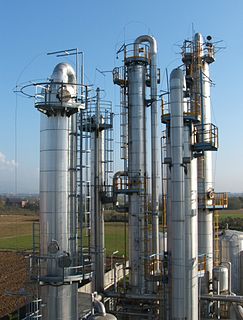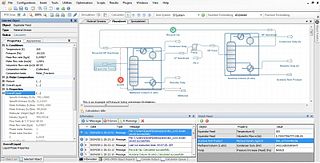
Chemical engineering is a certain type of engineering which deals with the study of operation and design of chemical plants as well as methods of improving production. Chemical engineers develop economical commercial processes to convert raw material into useful products. Chemical engineering uses principles of chemistry, physics, mathematics, biology, and economics to efficiently use, produce, design, transport and transform energy and materials. The work of chemical engineers can range from the utilization of nanotechnology and nanomaterial in the laboratory to large-scale industrial processes that convert chemicals, raw materials, living cells, microorganisms, and energy into useful forms and products. Chemical engineers are involved in many aspects of plant design and operation, including safety and hazard assessments, process design and analysis, modeling, control engineering, chemical reaction engineering, nuclear engineering, biological engineering, construction specification, and operating instructions.

Systems engineering is an interdisciplinary field of engineering and engineering management that focuses on how to design, integrate, and manage complex systems over their life cycles. At its core, systems engineering utilizes systems thinking principles to organize this body of knowledge. The individual outcome of such efforts, an engineered system, can be defined as a combination of components that work in synergy to collectively perform a useful function.

A system on a chip, also written as system-on-a-chip and system-on-chip, is an integrated circuit that integrates all or most components of a computer or other electronic system. These components almost always include a central processing unit (CPU), memory interfaces, on-chip input/output devices and secondary storage interfaces, often alongside other components such as radio modems and a graphics processing unit (GPU) – all on a single substrate or microchip. It may contain digital, analog, mixed-signal, and often radio frequency signal processing functions.
Process engineering is the understanding and application of the fundamental principles and laws of nature that allow humans to transform raw material and energy into products that are useful to society, at an industrial level. By taking advantage of the driving forces of nature such as pressure, temperature and concentration gradients, as well as the law of conservation of mass, process engineers can develop methods to synthesize and purify large quantities of desired chemical products. Process engineering focuses on the design, operation, control, optimization and intensification of chemical, physical, and biological processes. Process engineering encompasses a vast range of industries, such as agriculture, automotive, biotechnical, chemical, food, material development, mining, nuclear, petrochemical, pharmaceutical, and software development. The application of systematic computer-based methods to process engineering is "process systems engineering".
Design for Six Sigma (DFSS) is an Engineering design process, business process management method related to traditional Six Sigma. It is used in many industries, like finance, marketing, basic engineering, process industries, waste management, and electronics. It is based on the use of statistical tools like linear regression and enables empirical research similar to that performed in other fields, such as social science. While the tools and order used in Six Sigma require a process to be in place and functioning, DFSS has the objective of determining the needs of customers and the business, and driving those needs into the product solution so created. It is used for product or process design in contrast with process improvement. Measurement is the most important part of most Six Sigma or DFSS tools, but whereas in Six Sigma measurements are made from an existing process, DFSS focuses on gaining a deep insight into customer needs and using these to inform every design decision and trade-off.

Ecological engineering uses ecology and engineering to predict, design, construct or restore, and manage ecosystems that integrate "human society with its natural environment for the benefit of both".
Modular design, or modularity in design, is a design principle that subdivides a system into smaller parts called modules, which can be independently created, modified, replaced, or exchanged with other modules or between different systems.
Scheduling is the process of arranging, controlling and optimizing work and workloads in a production process or manufacturing process. Scheduling is used to allocate plant and machinery resources, plan human resources, plan production processes and purchase materials.

Pinch analysis is a methodology for minimising energy consumption of chemical processes by calculating thermodynamically feasible energy targets and achieving them by optimising heat recovery systems, energy supply methods and process operating conditions. It is also known as process integration, heat integration, energy integration or pinch technology.
The William O. Baker Award for Initiatives in Research, previously the NAS Award for Initiatives in Research, is awarded annually by the National Academy of Sciences "to recognize innovative young scientists and to encourage research likely to lead toward new capabilities for human benefit. The award is to be given to a citizen of the United States, preferably no older than 35 years of age. The field of presentation rotates among the physical sciences, engineering, and mathematics."
Water pinch analysis (WPA) originates from the concept of heat pinch analysis. WPA is a systematic technique for reducing water consumption and wastewater generation through integration of water-using activities or processes. WPA was first introduced by Wang and Smith. Since then, it has been widely used as a tool for water conservation in industrial process plants. Water Pinch Analysis has recently been applied for urban/domestic buildings. It was extended in 1998 by Nick Hallale at the University of Cape Town, who developed it as a special case of mass exchange networks for capital cost targeting.

Process simulation is used for the design, development, analysis, and optimization of technical processes such as: chemical plants, chemical processes, environmental systems, power stations, complex manufacturing operations, biological processes, and similar technical functions.
Hydrogen pinch analysis (HPA) is a hydrogen management method that originates from the concept of heat pinch analysis. HPA is a systematic technique for reducing hydrogen consumption and hydrogen generation through integration of hydrogen-using activities or processes in the petrochemical industry, petroleum refineries hydrogen distribution networks and hydrogen purification.
Professor Bodo Linnhoff is a chemical engineer and academic who developed Pinch Analysis, a methodology for minimising energy usage in the process industries. In its early days, the technique helped companies such as ICI and BASF to design plants that used roughly 30% less energy. As of the 1990s, Pinch Analysis became industrial standard in the oil refining and petrochemical industries. In 2010, Linnhoff founded a finance company, Harvester International, which nurtures innovation and guides smaller companies, such as Inview Technology.
SmartDO is a multidisciplinary design optimization software, based on the Direct Global Search technology developed and marketed by FEA-Opt Technology. SmartDO specialized in the CAE-Based optimization, such as CAE, FEA, CAD, CFD and automatic control, with application on various physics phenomena. It is both GUI and scripting driven, allowed to be integrated with almost any kind of CAD/CAE and in-house codes.
Green engineering approaches the design of products and processes by applying financially and technologically feasible principles to achieve one or more of the following goals: (1) decrease in the amount of pollution that is generated by a construction or operation of a facility, (2) minimization of human population exposure to potential hazards, (3) improved uses of matter and energy throughout the life cycle of the product and processes, and (4) maintaining economic efficiency and viability. Green engineering can an overarching framework for all design disciplines.

pSeven is a DSE software platform developed by DATADVANCE, extending design, simulation and analysis capabilities and assisting in smarter and faster design decisions. It provides a seamless integration with third party CAD and CAE software tools, powerful multi-objective and robust optimization algorithms, data analysis and uncertainty quantification tools.
Efstratios N. (Stratos) Pistikopoulos is a distinguished research Professor at the Department of Chemical Engineering at Texas A&M University, as well as the Director of the Texas A&M Energy Institute. From 1991-2015, he was a Professor for Chemical Engineering at Imperial College, where he pioneered multi-parametric programming and invented the concept of explicit or multi-parametric model predictive control. He has authored and co/authored more than 350 peer reviewed journal articles, authored and/or edited 9 books and has been an invited speaker to many academic conferences and lectures, including the 21st Professor Roger W. H. Sargent lecture at Imperial College London entitled "Multi-Parametric Programming & Control 25 years later: what is next?". Additionally, Professor Pistikopoulos has been elected a fellow of the Royal Academy of Engineering in 2013.
Aspen Plus, Aspen HYSYS, ChemCad and MATLAB, PRO are the commonly used process simulators for modeling, simulation and optimization of a distillation process in the chemical industries. Distillation is the technique of preferential separation of the more volatile components from the less volatile ones in a feed followed by condensation. The vapor produced is richer in the more volatile components. The distribution of the component in the two phase is governed by the vapour-liquid equilibrium relationship. In practice, distillation may be carried out by either two principal methods. The first method is based on the production of vapor boiling the liquid mixture to be separated and condensing the vapors without allowing any liquid to return to the still. There is no reflux. The second method is based on the return of part of the condensate to still under such conditions that this returning liquid is brought into intimate contact with the vapors on their way to condenser.






